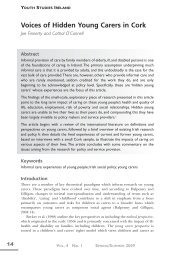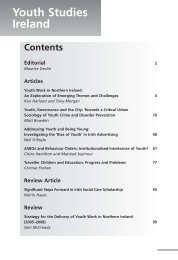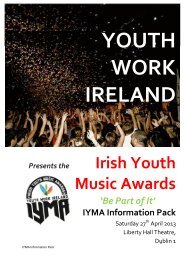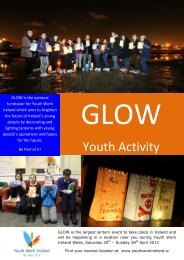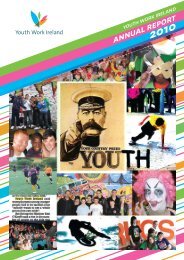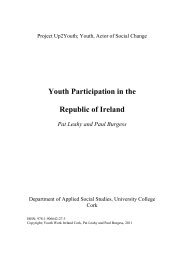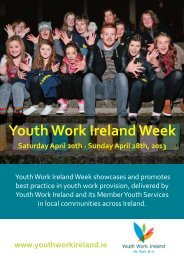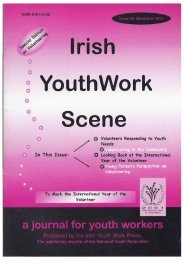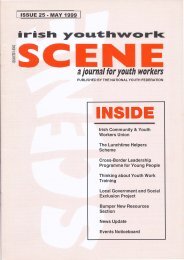Youth Work in Northern Ireland:
Youth Work in Northern Ireland:
Youth Work in Northern Ireland:
Create successful ePaper yourself
Turn your PDF publications into a flip-book with our unique Google optimized e-Paper software.
<strong>Youth</strong> <strong>Work</strong> <strong>in</strong> <strong>Northern</strong> <strong>Ireland</strong>contentious work is the trust they have with the youth worker. It is important thatyouth workers are aware of their potential to communicate to young people the valuesof compassion, understand<strong>in</strong>g and acceptance of others. <strong>Youth</strong> workers have hugepotential to serve as alternative role models and by their example can encourage thesevalues both <strong>in</strong> the young people they are immediately <strong>in</strong>volved with and other youngpeople <strong>in</strong> the community. By do<strong>in</strong>g so, youth workers can help young people achievea broader understand<strong>in</strong>g and tolerance of issues such as sexuality, disability, cultureand tradition (Department of Education, 1997: 10).<strong>Youth</strong> work should allow young people to explore and question the orig<strong>in</strong>s of theirvalues and beliefs and to ga<strong>in</strong> a deeper awareness of the op<strong>in</strong>ions and beliefs of others.<strong>Youth</strong> workers can help young people ga<strong>in</strong> understand<strong>in</strong>g through discuss<strong>in</strong>g moraland spiritual issues, values relat<strong>in</strong>g to ‘right and wrong’, honesty, truth, <strong>in</strong>tegrity, rightsand responsibilities, respect for other people and their property (Department ofEducation, 1997). It is important to enable young people to recognise bias, exam<strong>in</strong>ealternative viewpo<strong>in</strong>ts and look for reliable sources of evidence. Aga<strong>in</strong>, this pr<strong>in</strong>ciplehas a particular resonance <strong>in</strong> <strong>Northern</strong> <strong>Ireland</strong>, where ‘views are often entrenched andwhere community divisions have affected all aspects of life’, even to the extent thatother types of conflict, prejudice and discrim<strong>in</strong>ation are <strong>in</strong> danger of be<strong>in</strong>g obscuredor ignored (Department of Education, 2003: 15).Current ChallengesThe values and pr<strong>in</strong>ciples outl<strong>in</strong>ed above, which emphasise such dimensions of youthwork as relationships, participation and education, and which rest on an <strong>in</strong>herentlypositive view of young people, are not necessarily compatible with the broader social,political and policy environment <strong>in</strong> which youth workers operate, and this <strong>in</strong>evitablycreates tensions and challenges.One very significant factor is the pervasive perception of youth as a ‘threat’ whichhas led to a number of policy <strong>in</strong>itiatives dur<strong>in</strong>g the last ten years related to control andmanagement (Jeffs & Smith, 1999). Some of these have <strong>in</strong>volved <strong>in</strong>creasedsurveillance. For example, there has been an <strong>in</strong>creased use of closed circuit television<strong>in</strong> shopp<strong>in</strong>g centres and enterta<strong>in</strong>ment areas specifically aimed at identify<strong>in</strong>gproblematic groups of young people. Not only has the perception of young people asa threat created a new way of deal<strong>in</strong>g with youth issues; it could be argued that youthwork itself has been shaped and <strong>in</strong>fluenced by these policy changes and practices.<strong>Youth</strong> workers have found themselves undertak<strong>in</strong>g work <strong>in</strong> areas where young peoplecongregate and appear to engage <strong>in</strong> behaviours that are perceived as deviant. Forexample, <strong>in</strong> response to concerns expressed by shop-owners and police, youth workershave been appo<strong>in</strong>ted to Belfast city centre as detached workers to engage with youngpeople on the streets. There is <strong>in</strong>creas<strong>in</strong>g recognition with<strong>in</strong> society of the potential ofyouth work to address the perceived negative behaviour of young people. However,those who look to youth workers may have little understand<strong>in</strong>g of the traditions orpr<strong>in</strong>ciples which have historically <strong>in</strong>formed and shaped youth work practice. Whatthey require is a ‘solution’ to a ‘problem’ – for example hooliganism, petty crime,teenage pregnancy, anti-social behaviour – and they are will<strong>in</strong>g to try youth work as analternative to CCTV or to employ<strong>in</strong>g a private security firm. If youth work is used <strong>in</strong>this way, its educational pr<strong>in</strong>ciples are likely to be compromised.7
YOUTH STUDIES IRELANDThese pr<strong>in</strong>ciples are also under threat from an <strong>in</strong>creas<strong>in</strong>gly ‘managerial’ policyapproach. While the government has <strong>in</strong> recent years (DfES, 2002) officially recognisedthe benefit of youth work, Ord (2004: 57) has argued that ‘at the same time it isdeny<strong>in</strong>g the ma<strong>in</strong> tool utilised for that benefit – the youth work process’. Smith (2003:79) has warned that ‘organis<strong>in</strong>g youth work around concepts like outcome, targets,curriculum and issue’ means there is a danger of los<strong>in</strong>g relationship as a def<strong>in</strong><strong>in</strong>gfeature of youth work practice through a reduction <strong>in</strong> the amount of time youthworkers spend with young people.A further challenge to purpose and pr<strong>in</strong>ciple arises from the provision of youthwork <strong>in</strong> <strong>in</strong>stitutional contexts such as school or other ‘contested spaces’. Whiledemands placed on youth workers are likely to <strong>in</strong>crease <strong>in</strong> future years as moreprofessions see the potential that youth work approaches offer, the voluntary pr<strong>in</strong>ciplemay be perceived by those professions as problematic (Jeffs & Smith, 1998/99). At thesame time, youth workers question whether they can do their job effectively whereattendance is compulsory. As Hand (1995) po<strong>in</strong>ts out, school-based youth work hassometimes developed ‘negotiated programmes’ or the agreement of a ‘contract’ at thestart of the project which blurs the voluntary issue. Much of the current school-basedyouth work is funded to target specific ‘problem youth’ such as ‘truants’, young people‘at risk’, the ‘disaffected’ and those referred by teachers, parents or social workers (Jeffs& Smith, 1999). In such cases it is at least questionable that participation is voluntary.For youth workers this poses an ethical dilemma; whether to protect and control youngpeople or respect their rights to self-determ<strong>in</strong>ation (Banks 1999).F<strong>in</strong>ally, there are challenges posed by the emphasis on combat<strong>in</strong>g social exclusionthrough youth work. Given that youth work has historically been engaged with botheducation and welfare provision, it is not surpris<strong>in</strong>g that it is at the forefront of effortsaimed at tackl<strong>in</strong>g social exclusion among children and young people: those fromdisadvantaged backgrounds, with special educational needs, children <strong>in</strong> care, Travellerchildren, teenage parents, and those caught <strong>in</strong> a cycle of poor school attendance, loweducational achievement and poorly paid employment (<strong>Youth</strong> Council for <strong>Northern</strong><strong>Ireland</strong>, 2001). In the light of this, Young (1999) believes it is important for youthworkers to keep focused on the fact that they do not work with young people solelybecause they are ‘<strong>in</strong> trouble’ or ‘cause trouble’. Indeed, youth work programmes thatfocus on particular issues such as harm-m<strong>in</strong>imisation or alternatives to school, may becriticised for address<strong>in</strong>g the symptoms rather than the root causes of the problem(Morgan et al., 2000). In this context it is both unrealistic and unfair to construct youthwork as a panacea for social exclusion or other contemporary social problems.Research Method and SampleThe rest of this paper documents some f<strong>in</strong>d<strong>in</strong>gs from an exploratory research project(Harland, Morgan and Muldoon, 2005) designed to <strong>in</strong>vestigate the perceptions ofyouth workers <strong>in</strong> <strong>Northern</strong> <strong>Ireland</strong> of the nature of youth work and of key issues <strong>in</strong>contemporary youth work practice, <strong>in</strong>clud<strong>in</strong>g how it applies to and addresses socialexclusion. Four focus groups were conducted (total 42 participants) with youthworkers who were experienced and currently practic<strong>in</strong>g <strong>in</strong> the field of communityyouth work, <strong>in</strong>clud<strong>in</strong>g students enrolled on the Postgraduate Diploma <strong>in</strong> Community<strong>Youth</strong> <strong>Work</strong> at the University of Ulster. A purposive sampl<strong>in</strong>g strategy was adopted and8 VOL. 1 NO. 1 AUTUMN 2006
<strong>Youth</strong> <strong>Work</strong> <strong>in</strong> <strong>Northern</strong> <strong>Ireland</strong>the respondents <strong>in</strong>cluded both professionally-qualified and non professionallyqualified‘<strong>in</strong>digenous’ workers. The participants represented a diverse range ofagencies from the statutory and voluntary sectors, came from a mix of urban and ruralbackgrounds and were roughly gender balanced (19 males, 23 females).The focus groups concentrated on a number of key issues: how workers def<strong>in</strong>edyouth work; how youth work’s outcomes could be measured; how they understood theessential skills needed for deliver<strong>in</strong>g youth work; how learn<strong>in</strong>g is delivered <strong>in</strong> differentyouth work contexts and to what extent (and how) youth work addresses socialexclusion. The groups were facilitated by an experienced researcher and a secondresearcher was present to take notes <strong>in</strong> l<strong>in</strong>e with best practice. All focus groups weretaped and subsequently transcribed. Participants were sent a written summary of theprelim<strong>in</strong>ary analysis of the focus group f<strong>in</strong>d<strong>in</strong>gs and <strong>in</strong>vited to validate the researcher’srecord and <strong>in</strong>terpretations, as well as to make additional comments.<strong>Youth</strong> <strong>Work</strong>ers’ Perceptions and ExperiencesThe Nature of <strong>Youth</strong> <strong>Work</strong>In general it was found that no one def<strong>in</strong>ition of youth work prevailed <strong>in</strong> the focusgroups and <strong>in</strong> fact many participants had difficulty com<strong>in</strong>g up with a clear statementof its nature. Responses <strong>in</strong>cluded: ‘help<strong>in</strong>g young people develop’; ‘personaldevelopment’; ‘help<strong>in</strong>g socially disadvantaged young people’; ‘provid<strong>in</strong>g opportunitiesfor young people’; ‘empower<strong>in</strong>g young people’; ‘it’s about citizenship education’;‘encompass<strong>in</strong>g everyth<strong>in</strong>g from education to personal and social development toemployment’; ‘it’s about self-esteem’.In fact there seemed to be more consensus on what youth work was not. Thefollow<strong>in</strong>g received broad agreement: ‘youth work has a different approach to formaleducation, it is applied differently’; ‘youth work is not about do<strong>in</strong>g th<strong>in</strong>gs for a youngperson, but do<strong>in</strong>g th<strong>in</strong>gs with a young person’; ‘it’s not like formal education or carriedout for a set period of time’; ‘you can’t work with young people alone, you’ve got towork with communities’; ‘youth work is not about controll<strong>in</strong>g young people’. Manyparticipants, therefore, def<strong>in</strong>ed youth work with reference to the formal educationsystem which they saw as fail<strong>in</strong>g a considerable proportion of young people. <strong>Youth</strong>work could play a valuable role <strong>in</strong> support<strong>in</strong>g young people who were struggl<strong>in</strong>g atschool. For these respondents, youth work is concerned with ‘young people who havehad bad experiences <strong>in</strong> the educational system’; ‘those whom the school system hasfailed’; ‘young people who leave school with no qualifications and live <strong>in</strong> areas of highsocial deprivation with little chance of gett<strong>in</strong>g a job’. For young people like this, thevoluntary and non-obligatory aspect of youth work was perceived as crucial to theyouth work process. Impos<strong>in</strong>g attendance requirements were deemedcounterproductive as it removed the locus of control from the young people.An important aspect of youth work is that it is not obligatory and young people havea choice. You can never say this is what we are go<strong>in</strong>g to do for the first six weeksbecause after three weeks a young person may choose not to be there. So your goalsmust suit the needs of young people and be appropriate to what they want.9
YOUTH STUDIES IRELANDThere was strong agreement that youth work should be ‘process’ rather than ‘product’orientated and be rooted firmly <strong>in</strong> the nature of relationship between the youth workerand the young person. Perhaps because of this emphasis on process, many participantshad difficulty articulat<strong>in</strong>g how youth workers set their goals when undertak<strong>in</strong>g youthwork. Repeatedly respondents stated that they primarily focused on build<strong>in</strong>grelationships with young people rather than specific or measurable outcomes. As onestated:<strong>Youth</strong> work is def<strong>in</strong>itely a process; there is no specific beg<strong>in</strong>n<strong>in</strong>g or end. How can yousay at the start what the end result will be? If a young person is empowered then heor she will decide the outcomes.The process with<strong>in</strong> youth work was generally seen to be cont<strong>in</strong>gent on the quality ofrelationship between a young person and a youth worker. Although most youth workwas primarily carried out with<strong>in</strong> groups, the work also had an important <strong>in</strong>dividualfocus. Participants believed that time spent with young people and build<strong>in</strong>g trust werecrucial factors <strong>in</strong> this relationship. For example:In our literacy programmes, the first th<strong>in</strong>g you have to do is develop a relationshipwith that young person. It is very embarrass<strong>in</strong>g for a young person to say ‘I don’tknow my alphabet,’ or ‘I can’t read a dictionary’. So a rapport is crucial so that youcan work together. The needs of every young person are different so you need adifferent relationship with every young person you work with.Whilst the respondents seemed to be agreed that mean<strong>in</strong>gful relationships were crucialto the youth work process, many struggled to articulate the purpose of youth workbeyond the relationship phase. <strong>Work</strong>ers found it difficult to offer an overall model ofyouth work that <strong>in</strong>corporated patterns of progression, specific content that wouldfacilitate progression and an evaluation process that would help identify, even quantify,hard evidence that empowerment and autonomy have taken root <strong>in</strong> the young person.Indeed, the majority of workers did not appear to th<strong>in</strong>k it was important to try anddeterm<strong>in</strong>e what the next phase would be: ‘young people def<strong>in</strong>e for themselves whatthey want from the relationship’. Statements such as this reveal the extent to whichyouth workers were struggl<strong>in</strong>g to def<strong>in</strong>e their <strong>in</strong>terventions with young people <strong>in</strong>terms of products and ‘outcomes’. For these youth workers products and outcomeswere always secondary to the youth work process and its unique emphasis onrelationships. One respondent expressed concern that youth work was ‘mov<strong>in</strong>gdangerously away from <strong>in</strong>formal to formal education’.A further important guid<strong>in</strong>g pr<strong>in</strong>ciple for many of these youth workers was positiverole model<strong>in</strong>g. In communities that experienced high levels of social deprivation, antisocialbehaviour and paramilitary <strong>in</strong>fluence, the young people they worked with weremost likely to be exposed to negative role models, and many did not have access to<strong>in</strong>terested positive alternatives, which is where youth work comes <strong>in</strong>.In the communities where I work young people rarely look to adults or parents forsupport. They have little access to positive role models and feel left to their owndevices. Through our relationship with young people we can become positive rolemodels to them.10 VOL. 1 NO. 1 AUTUMN 2006
<strong>Youth</strong> <strong>Work</strong> <strong>in</strong> <strong>Northern</strong> <strong>Ireland</strong>Many participants po<strong>in</strong>ted to the importance of flexibility and creativity; a will<strong>in</strong>gnessand ability to f<strong>in</strong>d and use alternative solutions to problems that young people mightencounter. Once aga<strong>in</strong> the process was deemed more important than the identificationof specific measurable aims and objective.All the young people I work with are different and at different stages of developmentso you have to work with each person differently. Our programmes try to reflect thisdifference. This is important, particularly when someone is fragile.It was recognised that to many people youth work might appear to take place with<strong>in</strong> avery loose framework. Despite this, participants were not concerned that they couldnot always articulate what occurs beyond the relationship phase of youth work. Indeed,they believed it was this flexibility that made <strong>in</strong>formal youth work approaches uniqueand dist<strong>in</strong>ct from formal education. For some, the absence of a rigid curriculum wasl<strong>in</strong>ked to the issue of labell<strong>in</strong>g young people.This is where non-formal education differs from formal education. We are not try<strong>in</strong>gto get a specific number of people through an exam. We don’t call them failures if theydon’t achieve a specific grade. This is a pessimistic orientation whereas youth workershave an optimistic outlook even when young people don’t reach certa<strong>in</strong> standards. Wedon’t label people as they do <strong>in</strong> school. Some may th<strong>in</strong>k this is simply naïve but for methis is the core of youth work.Social ExclusionMost participants perceived themselves as work<strong>in</strong>g <strong>in</strong> some capacity with young peoplewho were socially disadvantaged or excluded. For many this was fundamental to whyyouth work was so important <strong>in</strong> <strong>Northern</strong> <strong>Ireland</strong>.<strong>Youth</strong> work has been go<strong>in</strong>g on all through ‘the troubles’. There are many excellentexamples of youth work go<strong>in</strong>g on beh<strong>in</strong>d the scenes and pick<strong>in</strong>g up the pieces of youngpeople’s lives and support<strong>in</strong>g them to understand issues that no one talks about suchas violence, sexual and mental health.The majority of participants worked <strong>in</strong> <strong>in</strong>ner city and rural areas with young people aged12–25. Their work was with the young unemployed, young homeless, ethnic m<strong>in</strong>orities,young people underachiev<strong>in</strong>g at school, young people <strong>in</strong>volved <strong>in</strong> crime, joy/death riders,teenage mothers and young fathers, young people abus<strong>in</strong>g drugs and alcohol, youngpeople with behavioural problems, young people with mental and sexual health problems,young people identified as marg<strong>in</strong>alised with<strong>in</strong> communities characterised by paramilitary<strong>in</strong>fluence, sectarianism, violence and marital breakdown. Typically the work took place <strong>in</strong>contested spaces such as <strong>in</strong>terface areas, city centres, on the streets, schools, parks and <strong>in</strong>communities with little or no youth provision. Notably, it was <strong>in</strong> discuss<strong>in</strong>g these issues thatrespondents appeared most passionate and energised.Some workers felt that this focus on social exclusion has been determ<strong>in</strong>ed by thechang<strong>in</strong>g social and political context <strong>in</strong> <strong>Northern</strong> <strong>Ireland</strong> over thirty-five years ofsectarian violence and political unrest. Initially, and to some extent more recently,<strong>Youth</strong> Service provision was primarily centre-based and located <strong>in</strong> the heart ofcommunities. This trend has radically changed recently with many professionally11
YOUTH STUDIES IRELANDtra<strong>in</strong>ed youth workers perceiv<strong>in</strong>g themselves as do<strong>in</strong>g more ‘specialist’ project andoutreach work us<strong>in</strong>g a variety of bases, leav<strong>in</strong>g youth centres to be run by <strong>in</strong>digenouspart-time youth workers. While some saw this as a necessary shift, others believed thatyouth centres were a valuable resource and their demise was detrimental to localcommunities. There was a general consensus however that the nature of fund<strong>in</strong>gsources and fund<strong>in</strong>g requirements have played a key role <strong>in</strong> the direction that youthwork has taken over the past decade. For some participants this was not necessarily <strong>in</strong>the best <strong>in</strong>terest of young people:In order to get fund<strong>in</strong>g now you have to demonstrate ways <strong>in</strong> which you are work<strong>in</strong>gwith ‘disadvantaged young people’. This has meant that the focus of youth work hasswitched from a focus on all young people to a focus on disadvantaged young people.The danger therefore is that youth work becomes issue focused rather than youngperson focused.There were participants who still perceived themselves as provid<strong>in</strong>g ‘traditional’ youthwork <strong>in</strong> youth centres. Typically however, these participants were local people who arenot professionally qualified and are either work<strong>in</strong>g voluntarily or part-time severalafternoons or even<strong>in</strong>gs per week. In contrast, the majority of professionally tra<strong>in</strong>edyouth workers did not work <strong>in</strong> ‘traditional’ youth centres. One participant spoke ofhow youth work has changed over the past number of years:In the past youth workers typically worked alone <strong>in</strong> a youth centre with part-time staff.Today there is much more emphasis on partnerships and work<strong>in</strong>g <strong>in</strong> the communitywith marg<strong>in</strong>alised young people. It is good that the skills of youth workers are moreappreciated by agencies such as Probation, Health Boards and even <strong>in</strong> schools. Thedanger is however, that youth workers are expected to be experts <strong>in</strong> these areas. It’sgood that th<strong>in</strong>gs are chang<strong>in</strong>g but I’m not sure that youth workers can be all th<strong>in</strong>gsto all people.Assess<strong>in</strong>g the Impact of <strong>Youth</strong> <strong>Work</strong>The majority of participants believed that the effectiveness of youth work ‘could notand should not be measured’. Others believed that its effectiveness was often selfevident.For <strong>in</strong>stance:I th<strong>in</strong>k work<strong>in</strong>g with young people <strong>in</strong> groups you can see development and growtheven if it is just they are gett<strong>in</strong>g on better with each or show<strong>in</strong>g more confidence….You can measure it, but it is very, very hard to put it down on paper.Another participant commented:<strong>Youth</strong> work has been criticised because we can’t measure outcomes. But how can youmeasure personal development or the impact that the work has had upon a youngperson. Sometimes it’s only years later that a young person realises the benefit theyhave had from be<strong>in</strong>g <strong>in</strong>volved <strong>in</strong> youth work programmes.Two key markers of achievement frequently mentioned were levels of participation(both <strong>in</strong> terms of frequency and duration) and the extent of relationship with youngpeople. For example, one participant stated: ‘We measure the number com<strong>in</strong>g through12 VOL. 1 NO. 1 AUTUMN 2006
<strong>Youth</strong> <strong>Work</strong> <strong>in</strong> <strong>Northern</strong> <strong>Ireland</strong>the door. We know how many young people attend and their <strong>in</strong>volvement <strong>in</strong> the club’.Another commented that ‘as a detached youth worker we can measure how manyyoung people we come <strong>in</strong>to contact with’. These <strong>in</strong>dicators should not be underestimated,particularly <strong>in</strong> socially disadvantaged areas, as they are evidence of youngpeople enter<strong>in</strong>g <strong>in</strong>to positive relationships with adults on a non-obligatory basis. Forthe most disadvantaged and excluded young people, this is a very positive‘measurement’.A large proportion of participants cited ‘<strong>in</strong>creased community <strong>in</strong>volvement’ as a key<strong>in</strong>dicator of success. <strong>Work</strong>ers spoke of young people gett<strong>in</strong>g <strong>in</strong>volved <strong>in</strong> issues with<strong>in</strong>their community that were important to them. Several participants mentioned‘citizenship education’ as a relatively new way of measur<strong>in</strong>g success. For some the factthat a young person now had the ‘confidence to lift the phone’ or ‘speak <strong>in</strong> front of agroup’ was an <strong>in</strong>dicator of success. Others spoke of young people from differentcommunities and traditions engag<strong>in</strong>g <strong>in</strong> youth exchanges, participat<strong>in</strong>g <strong>in</strong> crosscommunityand <strong>in</strong>ternational programmes and embrac<strong>in</strong>g active citizenship as positiveoutcomes.An <strong>in</strong>terest<strong>in</strong>g perspective on the subject of youth work’s impact was provided by ayouth worker who did not participate <strong>in</strong> the focus groups but who was <strong>in</strong>terviewedseparately <strong>in</strong> another strand of this research project. He placed the issue ofmeasurement <strong>in</strong> the context of his own work deal<strong>in</strong>g with very disadvantaged youngpeople and extreme <strong>in</strong>ter-community tension.For example at our last residential some of the lads came back say<strong>in</strong>g I have nevertasted water from the mounta<strong>in</strong> spr<strong>in</strong>g. Instead of tell<strong>in</strong>g them it is ‘bogg<strong>in</strong>’, you stopthe van and get them to get two big bottles of water and dr<strong>in</strong>k it. Maybe it’s becausethey haven’t done that before …a wee special moment. Whether you see simple th<strong>in</strong>gslike this as community relations doesn’t really matter. It mightn’t be the big picture, butwhen you have to give <strong>in</strong>dicators and measure th<strong>in</strong>gs surely this is still important.How do you measure a change <strong>in</strong> someone’s attitude? How do you measure someonewho has been through an extremely bad experience and has moved a little bit comparedto someone who has not been through much? If you take an area like [this one] thenit may be ten times harder to get some young person on a cross-community project thanit would be somewhere else. Yet how do you measure that?Key ChallengesMany focus group respondents felt that they were respond<strong>in</strong>g to crises with<strong>in</strong> theircommunities rather than be<strong>in</strong>g <strong>in</strong>volved <strong>in</strong> support<strong>in</strong>g young people. For example,they were under pressure to address anti-social behaviour amongst young people <strong>in</strong>response to community concerns. There was a fear that youth work would overly focuson ‘sort<strong>in</strong>g young people out’ rather than offer<strong>in</strong>g them supportive, creative andexcit<strong>in</strong>g learn<strong>in</strong>g opportunities.There were serious concerns voiced regard<strong>in</strong>g the nature of resource allocationand <strong>in</strong> particular fund<strong>in</strong>g arrangements for youth work. One respondent explicitlystated that youth work fund<strong>in</strong>g ‘makes youth work problem-oriented’. The need foryouth workers to be <strong>in</strong>volved <strong>in</strong> secur<strong>in</strong>g fund<strong>in</strong>g for the cont<strong>in</strong>uance of projects wasalso a major concern. For many, the demands on time and energy to complete13
YOUTH STUDIES IRELANDcumbersome fund<strong>in</strong>g applications took them away from what they perceived as ‘thereal bus<strong>in</strong>ess of work<strong>in</strong>g with young people’. Participants were also concerned that the‘competitive nature of fund<strong>in</strong>g’ has had a negative effect on youth work. As oneparticipant stated:<strong>Youth</strong> work has become competitive and that underm<strong>in</strong>es traditional youth workvalues. The nature of fund<strong>in</strong>g now determ<strong>in</strong>es what we do with young people ratherthan the issues that young people feel are important.A number of participants believed that this problem was exacerbated by the top-downorientation of government policy.We keep wait<strong>in</strong>g on the next government policy or priority to tell us what needs to bedone with young people. Often it is youth workers who are at the coal-face and knowwhat the needs of young people are. But we are told what to do with young people bypolicy makers and funders.Both the status of youth work and the role of the youth worker were also of concern torespondents, particularly those who had received professional tra<strong>in</strong><strong>in</strong>g <strong>in</strong> youth work.Some felt uncomfortable with the fact that ‘anyone work<strong>in</strong>g with young people can callthemselves a youth worker’. While acknowledg<strong>in</strong>g the fact that volunteers and nonqualifiedyouth workers provide an important service to young people, some qualifiedworkers believed that only those with professional tra<strong>in</strong><strong>in</strong>g should be formally recognisedas youth workers. They believed that <strong>in</strong>itial professional tra<strong>in</strong><strong>in</strong>g is essential <strong>in</strong> order foryouth workers to understand the ‘skills, knowledge and experience needed to work withyoung people’. These participants expressed concern that youth workers were oftenperceived as ‘less professional than school teachers, social workers and other professionals’.In contrast, non-qualified participants believed that it was more important for youthworkers to be ‘passionate about the work’ and prepared to be ‘available to young people atall times’. These <strong>in</strong>digenous youth workers felt they had more knowledge of the youngpeople they work with and were more accessible. While the non-qualified workers werevery articulate <strong>in</strong> discuss<strong>in</strong>g the issues confront<strong>in</strong>g young people <strong>in</strong> their communities, theyhad more difficulty engag<strong>in</strong>g <strong>in</strong> discussion about the nature and purpose of youth work.Some participants with many years’ experience drew attention to the ways <strong>in</strong> whichthe nature of youth work <strong>in</strong> <strong>Northern</strong> <strong>Ireland</strong> has changed. They identified ‘thetroubles’ and difficult socio-economic circumstances as hav<strong>in</strong>g an adverse affect oncommunities and young people.Be<strong>in</strong>g a youth worker is different now than it was twenty years ago. The essence ofyouth work is no longer simply to get young people off the streets and <strong>in</strong>to youth clubs.<strong>Youth</strong> workers are expected to engage young people who have particular difficultiesand provide a service that attempts to meet all their needs.Another youth worker highlighted the <strong>in</strong>creas<strong>in</strong>g complexity of young people’s livesand therefore of the work itself.It’s only <strong>in</strong> recent years that youth workers have recognised the need to address issuessuch as suicide and mental health and the importance of diet and the environment.Young peoples’ lives are becom<strong>in</strong>g more and more complicated and the transition <strong>in</strong>toadulthood is more prolonged.14 VOL. 1 NO. 1 AUTUMN 2006
<strong>Youth</strong> <strong>Work</strong> <strong>in</strong> <strong>Northern</strong> <strong>Ireland</strong>A further significant challenge for youth work <strong>in</strong> the <strong>Northern</strong> <strong>Ireland</strong> context washighlighted <strong>in</strong> the <strong>in</strong>-depth <strong>in</strong>terview with the youth worker <strong>in</strong> the area experienc<strong>in</strong>gsevere sectarian tension. In this area and others like it young people’s <strong>in</strong>volvement <strong>in</strong>riot<strong>in</strong>g is commonplace, may even be seen as a manifestation of community solidarity.It also provides excitement, a regular ‘buzz’. It is difficult for traditional youth work tocompete with this.There are huge numbers who don’t even want to attend clubs. Most say the place isbor<strong>in</strong>g and shudder <strong>in</strong> horror at the thought of go<strong>in</strong>g to the youth club.Discussion: Emerg<strong>in</strong>g Themes and ChallengesThe comment just quoted makes it clear that a major challenge fac<strong>in</strong>g youth workersand educationalists is the need for a more <strong>in</strong>novative way of educat<strong>in</strong>g and learn<strong>in</strong>gthat can tackle issues associated with grow<strong>in</strong>g-up <strong>in</strong> a ‘post-conflict’ society. <strong>Youth</strong> work<strong>in</strong> <strong>Northern</strong> <strong>Ireland</strong> takes place with<strong>in</strong> the context of a contested and divided societyemerg<strong>in</strong>g from over thirty five years of conflict and political unrest. Throughout thisconflict, youth workers have consistently been at the coal-face of political, communityand sectarian violence that has impacted upon the lives of young people. While themesof community relations, political education, citizenship and civic participation emergedthroughout the research, there appeared to be a lack of clarity or agreement amongstyouth workers about their role <strong>in</strong> this type of work or how it should be implemented.In certa<strong>in</strong> communities it is perhaps aspirational to expect youth workers to be able topersuade young people that they have a future role <strong>in</strong> a civic society. Civic participation<strong>in</strong> the face of such disadvantage requires broader social <strong>in</strong>itiatives than <strong>in</strong>formaleducation, not just from youth workers, but from all those who work with disaffectedyoung people.It is certa<strong>in</strong>ly a challenge to f<strong>in</strong>d sufficient resources <strong>in</strong> order to develop alternativeand more creative ways of support<strong>in</strong>g young people from communities who directlyexperience political conflict and violence. This is particularly pert<strong>in</strong>ent as EuropeanPeace monies dry up and many projects which evolved as a result of the troubles <strong>in</strong><strong>Northern</strong> <strong>Ireland</strong> are be<strong>in</strong>g abruptly term<strong>in</strong>ated. The impact of short-term fund<strong>in</strong>gupon the practice and development of youth work and the effect of this upon youngpeople <strong>in</strong> <strong>Northern</strong> <strong>Ireland</strong> has not been, and perhaps never will be, fully measured.Critically however, challenges to deliver<strong>in</strong>g youth work <strong>in</strong> contested spaces are notsolely about resources. There are ethical questions about the motivation of youthworkers and the extent to which their subjective political beliefs <strong>in</strong>fluence theirrelationships with young people. These are challeng<strong>in</strong>g but important issues that mustbe addressed by the <strong>Youth</strong> Service <strong>in</strong> <strong>Northern</strong> <strong>Ireland</strong>, particularly as <strong>in</strong>volv<strong>in</strong>g youngpeople and support<strong>in</strong>g their active participation <strong>in</strong> shap<strong>in</strong>g the future of <strong>Northern</strong><strong>Ireland</strong> is a high priority for funders and policy makers.These funders and policy makers <strong>in</strong>creas<strong>in</strong>gly require youth workers to articulatemore precisely the value of their work <strong>in</strong> terms of measurable outcomes. It wasapparent that the majority of youth workers <strong>in</strong> this study struggled to identifyoutcomes beyond the <strong>in</strong>itial relationship phase of their work. Although youth workersspoke of <strong>in</strong>creased confidence and self-esteem amongst the young people they workedwith, they found it difficult to express these <strong>in</strong> more measurable or quantifiable terms.15
YOUTH STUDIES IRELANDWhile a person-centred approach has always been a fundamental aspect of youth work,<strong>in</strong> an ever-chang<strong>in</strong>g fund<strong>in</strong>g and policy context, more concrete outcomes are nowexpected. This emerg<strong>in</strong>g trend has created particular tensions for youth workers whofeel pressurised to concentrate on the ‘product’ aspect of their programmes ratherthan youth work’s historical emphasis on ‘process.’ Indeed, this reorientation appearsto be happen<strong>in</strong>g without the consent or engagement of those at the forefront of youthwork practice. Those <strong>in</strong>terested <strong>in</strong> monitor<strong>in</strong>g youth work and its effects need to take<strong>in</strong>to consideration the difficulties youth workers are experienc<strong>in</strong>g adjust<strong>in</strong>g to this newparadigm. The fact that some socially excluded young people actually participated <strong>in</strong>a youth work programme at all was <strong>in</strong> itself seen as a highly significant ‘product’ bysome respondents. On the positive side, however, develop<strong>in</strong>g the ability to offer moreconcrete and tangible evidence of effectiveness and to adhere to agreed standards ofpractice offers youth work the opportunity to be accorded greater recognition and ahigher status and value amongst funders, policy makers and other professionalswork<strong>in</strong>g with young people.<strong>Youth</strong> work <strong>in</strong> <strong>Northern</strong> <strong>Ireland</strong> has a clear ethos and a set of values and pr<strong>in</strong>ciplesthat underp<strong>in</strong> its approach. In this sense it is clearly a profession. Importantly however,there may be aspects of youth work that people may be capable of do<strong>in</strong>g whether theyare qualified or not. Indeed, this may be a key reason why youth work is so dist<strong>in</strong>ctive.In address<strong>in</strong>g issues of professionalisation it is necessary to acknowledge the myriadsof hours that thousands of volunteers commit to young people each year. However,there are few other professions where those who are not professionally qualified aregiven the same title as tra<strong>in</strong>ed professionals. There is a need for much more rigour andclarity <strong>in</strong> the def<strong>in</strong>ition of the roles of all those who engage with young people. This isall the more important when youth work is practised <strong>in</strong> complex environments such asschools and communities <strong>in</strong> conflict. It is given added urgency now that the decisionhas been taken by the relevant professional and educational bodies to raise thethreshold for entry to youth work as a profession and all programmes of <strong>in</strong>itialundergraduate tra<strong>in</strong><strong>in</strong>g – <strong>in</strong>clud<strong>in</strong>g the only course available <strong>in</strong> <strong>Northern</strong> <strong>Ireland</strong> atthe University of Ulster – are to become degree-level programmes.It is important however to acknowledge that the development of youth work as aprofession will depend on more than provid<strong>in</strong>g professional tra<strong>in</strong><strong>in</strong>g to non-qualifiedyouth workers and <strong>in</strong>creas<strong>in</strong>g the level and duration of such tra<strong>in</strong><strong>in</strong>g. France & Wiles(1997:13) have argued <strong>in</strong> the UK that there must be improvements <strong>in</strong> projectmanagement, monitor<strong>in</strong>g and evaluation. They also suggest that youth work lacks acoherent, self-govern<strong>in</strong>g professional organisation and the leadership to develop thenew skills and th<strong>in</strong>k<strong>in</strong>g a modern <strong>Youth</strong> Service requires. The <strong>Youth</strong> Service LiaisonForum set up <strong>in</strong> 2003 identified the lack of a co-ord<strong>in</strong>ated strategy as a stumbl<strong>in</strong>g blockto the development of the <strong>Youth</strong> Service <strong>in</strong> <strong>Northern</strong> <strong>Ireland</strong>. In response to this theForum produced a Strategy for the Delivery of <strong>Youth</strong> <strong>Work</strong>: 2005–2008 (<strong>Youth</strong> ServiceLiaison Forum 2005). The sett<strong>in</strong>g up of the Forum and the publication of the youthwork strategy is a very positive step, particularly as there was a process of consultationwith youth workers. It is to be hoped that the strategy, and any new youth workstructures which emerge out of the recent Review of Public Adm<strong>in</strong>istration <strong>in</strong> <strong>Northern</strong><strong>Ireland</strong> (2006) can go some way to address<strong>in</strong>g the key issues and challenges outl<strong>in</strong>ed<strong>in</strong> this paper.16 VOL. 1 NO. 1 AUTUMN 2006
<strong>Youth</strong> <strong>Work</strong> <strong>in</strong> <strong>Northern</strong> <strong>Ireland</strong>AcknowledgementsThe authors would like to acknowledge the contribution made by the Department ofEducation (<strong>Northern</strong> <strong>Ireland</strong>) for fund<strong>in</strong>g the research project and the work of DrOrla Muldoon <strong>in</strong> the orig<strong>in</strong>al research.ReferencesBamber, J. (2002) ‘Educational Groupwork and Active Citizenship’, <strong>Youth</strong> & Policy, 74: 1–16.Banks, S. (1999) Ethical Issues <strong>in</strong> <strong>Youth</strong> <strong>Work</strong>. London: Routledge.Department of Education (1997) <strong>Youth</strong> <strong>Work</strong>: A Model For Effective Practice. Belfast: Department forEducation for <strong>Northern</strong> <strong>Ireland</strong>.Department of Education (2000) A <strong>Youth</strong> Service for a New Millennium. Belfast: Department forEducation for <strong>Northern</strong> <strong>Ireland</strong>.Department of Education (2003) <strong>Youth</strong> <strong>Work</strong>: A Model For Effective Practice (revised). Belfast:Department for Education for <strong>Northern</strong> <strong>Ireland</strong>.DfES (2002) Transform<strong>in</strong>g <strong>Youth</strong> <strong>Work</strong>: Resourc<strong>in</strong>g Excellent <strong>Youth</strong> Services. Nott<strong>in</strong>gham: Departmentfor Education and Skills.Doyle, M. E. & Smith, M. K. (1999). Born and Bred? Leadership, Heart and Informal Education.London: YMCA George Williams College/Rank Foundation.France, A, & Wiles, P. (1997) ‘The <strong>Youth</strong> Action Scheme and the Future of <strong>Youth</strong> <strong>Work</strong>’,<strong>Youth</strong> & Policy, 57: 1–16.Hand, J. (1995) Rais<strong>in</strong>g Standards <strong>in</strong> Schools: The <strong>Youth</strong> <strong>Work</strong> Contribution. Leicester: <strong>Youth</strong> <strong>Work</strong>Press.Harland, K. (2001) ‘The challenges and potential of develop<strong>in</strong>g a more effective youth workcurriculum with young men’, Child Care <strong>in</strong> Practice, 7, 4: 288–300.Harland, K., Morgan, T. & Muldoon, O. (2005) The Nature of <strong>Youth</strong> <strong>Work</strong> <strong>in</strong> <strong>Northern</strong> <strong>Ireland</strong>:Purpose, Contribution and Challenges. Belfast: Department of Education. www.deni.gov.uk/rb2_2005.pdfHenriques, B. (1933) Club Leadership. London: Oxford University Press.Jeffs, T. & Smith, M.K. (1998/99). ‘The Problem of “<strong>Youth</strong>” for <strong>Youth</strong> <strong>Work</strong>’, <strong>Youth</strong> & Policy,62: 45–66.Jeffs, T. (2001) ‘Someth<strong>in</strong>g to give and someth<strong>in</strong>g to learn’, <strong>in</strong> R. Gilchrist & T. Jeffs (eds)Settlements, Social Change and Community Action. London: Jessica K<strong>in</strong>gsley.McCartney, Clem (1999) Unattached <strong>Youth</strong> Programme. Belfast: <strong>Northern</strong> <strong>Ireland</strong> Voluntary Trust.M<strong>in</strong>istry of Education (1960) The <strong>Youth</strong> Service <strong>in</strong> England and Wales (‘The Albemarle Report’).London: HMSO.Morgan, T., O’Hare, B. & Campbell, H. (2000) The Excluded Adolescent. Research funded by<strong>Youth</strong>Net and the <strong>Youth</strong> Council for <strong>Northern</strong> <strong>Ireland</strong>.Murphy, H. (1999) Purposes – Why is <strong>Youth</strong> <strong>Work</strong> Important? Concept Reader <strong>in</strong> conjunction withScottish <strong>Youth</strong> Lobby. Ed<strong>in</strong>burgh: Community Learn<strong>in</strong>g Scotland.Ord, J. (2004) ‘The youth work curriculum and the Transform<strong>in</strong>g <strong>Youth</strong> <strong>Work</strong> agenda’,<strong>Youth</strong> & Policy, 83: 43–59.Review of Public Adm<strong>in</strong>istration (August 2006) www.rpani.gov.uk/august_rpa_bullet<strong>in</strong>-2.pdf17
YOUTH STUDIES IRELANDSmith, M. K. (2002) ‘Transform<strong>in</strong>g <strong>Youth</strong> <strong>Work</strong>: Resourc<strong>in</strong>g Excellent <strong>Youth</strong> Services. A Critique.’ <strong>in</strong>fed:the <strong>in</strong>formal education homepage. www.<strong>in</strong>fed.org/youthwork/transform<strong>in</strong>gyouthworkSmith, M. K. (2003) ‘From youth work to youth development’, <strong>Youth</strong> & Policy, 79: 46–59.Young, K. (1999) The Art of <strong>Youth</strong> <strong>Work</strong>. Dorset: Russell House Publish<strong>in</strong>g.<strong>Youth</strong> Council for <strong>Northern</strong> <strong>Ireland</strong> (2001). The Debate on Social Exclusion: Causes andManifestations. Belfast: <strong>Youth</strong> Council for <strong>Northern</strong> <strong>Ireland</strong>.<strong>Youth</strong> Service Liaison Forum (2005) Strategy for the Delivery of <strong>Youth</strong> <strong>Work</strong> <strong>in</strong> <strong>Northern</strong> <strong>Ireland</strong>2005–2008. Belfast: Department of Education.Biographical NoteDr Ken Harland is a lecturer <strong>in</strong> Community <strong>Youth</strong> <strong>Work</strong> and co-director of the Centrefor Young Men’s Studies at the University of Ulster. His major research <strong>in</strong>terests<strong>in</strong>clude youth work, young men and mascul<strong>in</strong>ity, young men and violence, young menand mental and emotional health.AddressCommunity <strong>Youth</strong> <strong>Work</strong> Department,School of Sociology and Applied Social Studies,Room 21C01,Dalriada,University of Ulster.BT39 OQBTel: +44-28-90368334Email: k.harland@ulster.ac.ukDr Tony Morgan is the Course Director for the Postgraduate Diploma/Masters <strong>in</strong> <strong>Youth</strong>and Community <strong>Work</strong> at the University of Ulster. He is the author of a variety ofreports and articles on marg<strong>in</strong>alised youth, lifelong learn<strong>in</strong>g and youth work, familysupport <strong>in</strong> <strong>Ireland</strong> and issues relat<strong>in</strong>g to the measurement of outcomes <strong>in</strong> youth work.AddressCommunity <strong>Youth</strong> <strong>Work</strong> Department,School of Sociology and Applied Social Studies,Room 21C10,Dalriada,University of Ulster.BT39 OQBTel: +44-28-90366688Email: t.morgan@ulster.ac.uk18 VOL. 1 NO. 1 AUTUMN 2006



